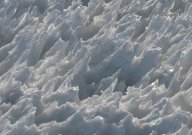Space & Astronomy
March 23, 2013 · 19 comments
19 comments

Image Credit: CC 3.0 Mark Sanderson
Penitentes form when irregularities in the snow are enhanced by the energy from the Sun, creating deep furrows. The debate is on over whether similar conditions could exist on Europa. "The Sun is always coming down straight from above on Europa," said Dr Daniel Hobley. "From our point of view, if the surface of Europa is subliming - if it is being sculpted by the sunlight - it will form these features."[!gad]Jupiter's icy moon is a strong contender for a future space mission due to the possibility that it hides a vast ocean of liquid water. Sending a spacecraft to Europa and landing on the surface is a difficult proposition in itself, but now scientists have pointed out that huge spikes of ice known as 'penitentes' may pose a deadly hazard to any probe attempting to touch down. Similar ice spikes can be found on Earth in high altitude regions such as the Andes.
Penitentes form when irregularities in the snow are enhanced by the energy from the Sun, creating deep furrows. The debate is on over whether similar conditions could exist on Europa. "The Sun is always coming down straight from above on Europa," said Dr Daniel Hobley. "From our point of view, if the surface of Europa is subliming - if it is being sculpted by the sunlight - it will form these features."
Source: BBC News | Comments (19)
Huge spikes of ice threaten Europa landing
By T.K. RandallMarch 23, 2013 ·
 19 comments
19 comments
Image Credit: CC 3.0 Mark Sanderson
A future Europa mission may need to contend with deadly jagged ice spikes littering the surface.
Jupiter's icy moon is a strong contender for a future space mission due to the possibility that it hides a vast ocean of liquid water. Sending a spacecraft to Europa and landing on the surface is a difficult proposition in itself, but now scientists have pointed out that huge spikes of ice known as 'penitentes' may pose a deadly hazard to any probe attempting to touch down. Similar ice spikes can be found on Earth in high altitude regions such as the Andes.Penitentes form when irregularities in the snow are enhanced by the energy from the Sun, creating deep furrows. The debate is on over whether similar conditions could exist on Europa. "The Sun is always coming down straight from above on Europa," said Dr Daniel Hobley. "From our point of view, if the surface of Europa is subliming - if it is being sculpted by the sunlight - it will form these features."[!gad]Jupiter's icy moon is a strong contender for a future space mission due to the possibility that it hides a vast ocean of liquid water. Sending a spacecraft to Europa and landing on the surface is a difficult proposition in itself, but now scientists have pointed out that huge spikes of ice known as 'penitentes' may pose a deadly hazard to any probe attempting to touch down. Similar ice spikes can be found on Earth in high altitude regions such as the Andes.
Penitentes form when irregularities in the snow are enhanced by the energy from the Sun, creating deep furrows. The debate is on over whether similar conditions could exist on Europa. "The Sun is always coming down straight from above on Europa," said Dr Daniel Hobley. "From our point of view, if the surface of Europa is subliming - if it is being sculpted by the sunlight - it will form these features."
Jupiter's icy moon Europa is a prime target for future space missions as it harbours a buried ocean that could have the right conditions for life.
Source: BBC News | Comments (19)

The Unexplained Mysteries
Book of Weird News
AVAILABLE NOW
Take a walk on the weird side with this compilation of some of the weirdest stories ever to grace the pages of a newspaper.
Click here to learn more

Support us on Patreon
BONUS CONTENTFor less than the cost of a cup of coffee, you can gain access to a wide range of exclusive perks including our popular 'Lost Ghost Stories' series.
Click here to learn more
Ancient Mysteries and Alternative History
Extraterrestrial Life and The UFO Phenomenon
UK and Europe
United States and the Americas
Total Posts: 7,607,262 Topics: 316,434 Members: 201,852
Not a member yet ? Click here to join - registration is free and only takes a moment!
Not a member yet ? Click here to join - registration is free and only takes a moment!




















Please Login or Register to post a comment.